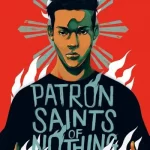
3 Sentence Summary
Yaa Gyasi’s novel Homegoing tells the story of seven generations of a family separated by slavery. One side remained in Africa, while the other was brought to America on a slave ship. The novel follows the descendants of this family as they live their lives, and eventually reunite in Ghana after two centuries.
Summary Read Time: Less than 7 minutes
Actual Book Length: 305
First Published in: 2016
Below is the detailed yet quick summary of the book:
Part 1
Effia is born during a raging fire in Fanteland and she grows up with a cruel mother named Baaba and a kind father named Cobbe. When Effia turns twelve, she begins to blossom into a young woman. She hopes to marry the next chief of the village, but Baaba has other plans for her. She tells Effia to hide her blood, and then contrives to have her marry a British man named James Collins who is the newly appointed governor of the Cape Coast Castle. Before Effia is married, Baaba gives her a black stone pendant—a piece of her mother.
Effia and James Collins develop a deep affection for each other after she moves into the castle. However, while living there she quickly discovers the horrors of women being traded as slaves in the castle dungeons. Effia is horrified by this discovery but feels she has no choice but to stay since she knows she can’t go back to her village. Years later, when she hears her father is dying, Effia returns home only to find out from her brother Fiifi that she is not Baaba’s daughter. Maame, Effia’s real mother, had been a house girl for Cobbe and ran away the night Effia was born. The black stone from Baaba is really from Maame.
Part 2
Esi is stuck in the women’s dungeon in the Cape Coast Castle as soldiers come and go, grope the women, and take away their children. Esi was born in Asanteland to a respected warrior, Kwame Asare. The Asantes had been raiding other villages for years, capturing prisoners and taking them as slaves and servants. Esi’s mother, Maame, took one of these prisoners as a house girl. But the girl (Abronoma) was not very skilled at housework and was often beaten. Esi felt bad for her, and agreed to send a message to her father, telling him where she was.
One night, while Abronoma’s father and other warriors were attacking the village, Maame was too afraid to run away. Instead, she gave Esi a black stone and told her to flee. Unfortunately, Esi was quickly captured and taken to the Castle where she was made to walk for days with little food or water. Back in the dungeon, a soldier pulled her out and raped her before returning her to the prison. Days later, Esi and the other women were taken onto a ship, but she lost her stone in the dungeon.
Quey, Effia’s son, returns to his mother’s village in order to make a deal about slave prices. Quey had always felt like he didn’t quite fit in, not belonging to either the white or black community. After James Collins’ death, Quey returns but still feels the disappointment his father had towards him. Not wanting to be seen as weak, Quey participates in the slave trade. When his Uncle Fiifi captures Nana Yaa, the daughter of an Asante king, to strengthen their political union, Quey is reluctant at first but eventually agrees to marry her.
Part 3
Ness, Esi’s daughter, is working on Thomas Allan Stockham’s plantation in Alabama. Ness doesn’t talk to her fellow slaves very often because her mother was a strong, silent woman with a tough heart. However, Ness does feel drawn to a young, motherless girl named Pinky who never speaks.
One day, the master’s son tries to get Pinky to speak, and threatens to beat her. Ness intervenes and prevents him from doing so. Afterwards, as Ness awaits her punishment for speaking out, she think about how she ended up in that situation.
Ness used to be a slave at another plantation. There, she was married to another slave named Sam. They had a son together, Kojo. When Kojo was born, they attempted to escape with a woman named Aku. However, one night when Ness gave Kojo to Aku to hold, they were caught by their former master – whom they refer to as the Devil. Aku and Kojo were able to escape, but Ness and Sam were not. Ness was whipped until she couldn’t stand, and Sam was hanged.
James, Quey, and Nana Yaa travel to Asanteland for her father’s funeral. While there, James meets Akosua – a girl who fascinates him but who also won’t shake his hand because his family takes part in the slave trade. Although he knows it would never be possible to marry her, he promises that if she waits for him, he will come back for her. When he returns to Fanteland, he’s married to another woman but he refuses to consummate the marriage while he plots to get back to Akosua. Eventually, he fakes his death in a battle and walks back to Asanteland where Akosua is waiting for him.
Part 4
Jo (Kojo), Ness’ son, manages a ship in Baltimore where he escaped to as a baby with his mother, Ma Aku, from the chains of slavery. He and his wife, Anna, who is also free, have six children with another on the way whom they have decided to name H.
Jo is afraid of the law enforcement in the city and constantly worried that he will be re-enslaved. On the day of his daughter’s wedding, the Fugitive Slave Act passes, meaning that if Jo is found out as a runaway, he can be sent back to the South to work on a plantation. One day, his wife does not return home. He looks for her for days, to no avail, until a young boy says that he saw a white man take her into his carriage.
Ten years pass, and Jo moves up to New York as more states start to secede, and the Civil War brews. When the war finally ends, he is relieved but also saddened, as he knows that his wife will never come back to him.
Abena, James’s daughter, is twenty-five years old and still unmarried. She’s in love with a man named Ohene Nyarko, but he can’t marry her until the harvest is good. They begin an affair anyway.
When the harvests in the village continue to be bad, they blame Abena for witchcraft. Ohene travels to another city and acquires a cocoa plant, which grows well. But he promises the man he buys it from that he’ll marry his daughter in return.
Abena, now pregnant, refuses to wait any longer for Ohene. She travels back to the heart of Asanteland to seek out the missionary church there.
Part 5
Jo and Anna’s son H was born on a plantation. His mother killed herself before he was born, so he was cut out of her stomach at birth. Although he was freed after the war, he was quickly imprisoned for looking at a white woman and sold to the mining system. He worked in brutal conditions for nine years before obtaining freedom again, and then worked in the mines as a free laborer. He joined a union, struck for better conditions, and reunited with his woman Ethe.
Akua, Abena’s daughter, was raised in the missionary church where she was given the message that she was a sinner and heathen. She left the church to marry Asamoah, but started having visions of a firewoman with two children. These visions led her to set fire to their hut one night, resulting in the death of two of her daughters and scarring her infant son, Yaw.
Willie, H’s daughter, marries a light-skinned boy named Robert Clifton when she is young. The two move up to Harlem with their son, Carson. Robert gets jobs easily but loses them when people find out that he is not white. Willie cleans houses, but at night she works at a jazz club. While cleaning the bathroom at the club one night, she runs into Robert, who is with two of his white co-workers. Realizing that they are married, the two white men force Robert to violate Willie for their own enjoyment. Robert leaves that night, and Willie tries to restart her life with another man named Eli.
Part 6
Yaw, Akua’s son, is a history teacher at an all-boys Roman Catholic high school. He is passionate about securing Ghanaian independence and resents his mother for the severe facial burn she inflicted upon him. However, he is eventually convinced by his house girl, Esther, to go and see her. The two are able to reconcile as Akua explains the evil that plagues their family history and that has haunted her ever since.
Sonny grows up resentful of Willie because she refuses to speak about Robert. He joins the Civil Rights movement and finds himself in and out of jail for marching. One day, he goes to a jazz club and becomes taken with a singer named Amani. Amani introduces him to dope, and Sonny quickly becomes addicted. His mother stops speaking to him until he resolves to get clean. However, after getting clean, Sonny realizes that he doesn’t want to go back to his old life. He wants to pursue music, and so he does. He turns his back on the Civil Rights movement and starts making a name for himself in the jazz world.
Marjorie, Yaw and Esther’s daughter, is born in Ghana but grows up in Alabama. She has trouble making friends in high school because the white students think she is black, while the black students think she sounds and acts like a white girl. Marjorie turns to reading and writing as an escape and spends most of her time alone. She eventually starts dating a white boy named Graham, but his father putting an end to their relationship. Marjorie goes back to Ghana every summer to visit her grandmother Akua, with whom she is very close.
Part 7
Marcus, Sonny, and Amani’s son is the focus of the final chapter in the novel. He is in the process of getting his Ph.D. in sociology from Stanford University. He starts off by studying the convict leasing system that had such a profound and negative impact on his great grandfather H’s life, but he quickly realizes there are many more aspects of systematic oppression in America that he wants to research and discuss.
Marcus and Marjorie meet while attending Stanford University and quickly become friends. They take a trip to Birmingham together and then travel to Ghana. There they are both struck by their shared history at the Cape Coast Castle. They reconcile their families’ differences by running into the water together on the beach. As a final act of reconciliation, Marjorie welcomes Marcus home and gives him the stone necklace that she inherited from her grandmother.





